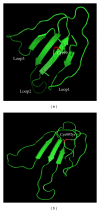Particular Mal de Meleda phenotypes in Tunisia and mutations founder effect in the Mediterranean region
- PMID: 24093092
- PMCID: PMC3777190
- DOI: 10.1155/2013/206803
Particular Mal de Meleda phenotypes in Tunisia and mutations founder effect in the Mediterranean region
Abstract
Mal de Meleda (MDM) is a rare, autosomal recessive form of palmoplantar keratoderma. It is characterized by erythema and hyperkeratosis of the palms and soles that progressively extend to the dorsal surface of the hands and feet. It is caused by mutations in SLURP-1 gene encoding for secreted mammalian Ly-6/uPAR-related protein 1 (SLURP-1). We performed mutational analysis by direct sequencing of SLURP-1 gene in order to identify the genetic defect in three unrelated families (families MDM-12, MDM-13, and MDM-14) variably affected with transgressive palmoplantar keratoderma. A spectrum of clinical presentations with variable features has been observed from the pronounced to the transparent hyperkeratosis. We identified the 82delT frame shift mutation in the SLURP-1 gene in both families MDM-12 and MDM-13 and the missense variation p.Cys99Tyr in family MDM-14. To date, the 82delT variation is the most frequent cause of MDM in the world which is in favour of a recurrent molecular defect. The p.Cys99Tyr variation is only described in Tunisian families making evidence of founder effect mutation of likely Tunisian origin. Our patients presented with very severe to relatively mild phenotypes, including multiple keratolytic pits observed for one patient in the hyperkeratotic area which was not previously reported. The phenotypic variability may reflect the influence of additional factors on disease characteristics. This report further expands the spectrum of clinical phenotypes associated with mutations in SLURP1 in the Mediterranean population.
Figures



Similar articles
-
A novel missense mutation in the gene encoding SLURP-1 in patients with Mal de Meleda from northern Tunisia.Br J Dermatol. 2003 Dec;149(6):1108-15. doi: 10.1111/j.1365-2133.2003.05606.x. Br J Dermatol. 2003. PMID: 14674887
-
Further evidence of the clinical and genetic heterogeneity of recessive transgressive PPK in the Mediterranean region.J Hum Genet. 2006;51(10):841-845. doi: 10.1007/s10038-006-0002-8. Epub 2006 Jul 25. J Hum Genet. 2006. PMID: 16865292
-
SLURP-1 is mutated in Mal de Meleda, a potential molecular signature for melanoma and a putative squamous lineage tumor suppressor gene.Int J Dermatol. 2018 Feb;57(2):162-170. doi: 10.1111/ijd.13850. Epub 2017 Dec 12. Int J Dermatol. 2018. PMID: 29231248
-
Mal de Meleda: A Focused Review.Am J Clin Dermatol. 2016 Feb;17(1):63-70. doi: 10.1007/s40257-015-0157-1. Am J Clin Dermatol. 2016. PMID: 26445964 Review.
-
Malignant melanoma developing in an area of hereditary palmoplantar keratoderma (Mal de Meleda).J Surg Oncol. 2003 Dec;84(4):229-33. doi: 10.1002/jso.10317. J Surg Oncol. 2003. PMID: 14756434 Review.
Cited by
-
Mal De Meleda with Flexural Involvement.Indian Dermatol Online J. 2022 Sep 5;13(5):636-639. doi: 10.4103/idoj.idoj_236_22. eCollection 2022 Sep-Oct. Indian Dermatol Online J. 2022. PMID: 36304642 Free PMC article.
-
Nagashima-type palmoplantar keratosis in a Chinese Han population.Mol Med Rep. 2016 Nov;14(5):4049-4054. doi: 10.3892/mmr.2016.5757. Epub 2016 Sep 21. Mol Med Rep. 2016. PMID: 27666198 Free PMC article.
-
A Case of Mal De Meleda: The Rare Presentation of Palmoplantar Keratoderma Disease.Cureus. 2021 Sep 17;13(9):e18061. doi: 10.7759/cureus.18061. eCollection 2021 Sep. Cureus. 2021. PMID: 34692287 Free PMC article.
-
Two Sisters with Mal de Meleda: Case Series Report.Int J Appl Basic Med Res. 2022 Apr-Jun;12(2):151-154. doi: 10.4103/ijabmr.ijabmr_812_21. Epub 2022 May 10. Int J Appl Basic Med Res. 2022. PMID: 35754677 Free PMC article.
-
Atypical Mal de Meleda in a Hispanic Patient.Case Rep Dermatol Med. 2023 Sep 14;2023:6640311. doi: 10.1155/2023/6640311. eCollection 2023. Case Rep Dermatol Med. 2023. PMID: 37744084 Free PMC article.
References
-
- Romdhane L, Abdelhak S. Genetic Disorders in North African Populations. Oxford University Press; 2012. (Genomics and Health in the Developing World).
-
- Bouadjar B, Benmazouzia S, Prud’homme J-F, Cure S, Fischer J. Clinical and genetic studies of 3 large, consanguineous, Algerian families with Mal de Meleda. Archives of Dermatology. 2000;136(10):1247–1252. - PubMed
-
- Marrakchi S, Audebert S, Bouadjar B, et al. Novel mutations in the gene encoding secreted lymphocyte antigen-6/urokinase-type plasminogen activator receptor-related protein-1 (SLURP-1) and description of five ancestral haplotypes in patients with Mal de Meleda. Journal of Investigative Dermatology. 2003;120(3):351–355. - PubMed
-
- Charfeddine C, Mokni M, Ben Mousli R, et al. A novel missense mutation in the gene encoding SLURP-1 in patients with Mal de Meleda from northern Tunisia. British Journal of Dermatology. 2003;149(6):1108–1115. - PubMed
-
- Frenk E, Guggisberg D, Mevorah B, Hohl D. Meleda disease: report of two cases investigated by electron microscopy. Dermatology. 1996;193(4):358–361. - PubMed
Publication types
MeSH terms
Substances
LinkOut - more resources
Full Text Sources
Other Literature Sources
Research Materials

